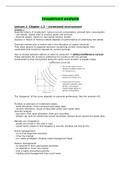Samenvatting
Summary Investment Analysis (323060-M-6) -
- Instelling
- Tilburg University (UVT)
Summary of lecture slides of IA from Note: does not include Markowitz portion of the subject, please refer to reader distributed by lecturer for that portion
[Meer zien]




